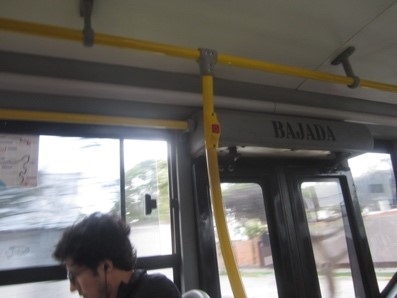Navigating Public Transportation in Peru


With extreme informality, crowds, and countless unwritten rules, Lima’s public transportation system can be overwhelming for newcomers—and even for Limeños. Here’s what I’ve learned over the semester.
Why the chaos?
The majority of public transport vehicles in Lima operate informally despite sporting the patterned paint of one parent company. Because the law for vehicle standards is very liberal, many of the vehicles are outdated and in need of constant repair. Additionally, the choferes (drivers) typically rent or purchase a vehicle and keep their earnings, minus a set amount for the parent company. This means they and the cobradores (fare collectors) have a significant incentive to take as many passengers as possible. There is always “room for one more.”

Although a small fleet of municipal buses have been launched in addition to the Bus Rapid Transit (BRT) system to run limited routes, the Metropolitano and an elevated railway called the Metro are still the backbone of public transportation and can take you to any part of the city.
Finding your route
In the first week, finding the best way to get to school from your home stay can make your head spin. IFSA Peru staff may show you one way to arrive, possibly utilizing larger buses to accommodate the entire group. This is likely to require a transfer, and figuring out where to get off and where to get the next bus can be challenging. There may be other options near your homestay to PUCP, so be sure to ask your host family or the IFSA Peru staff.
The TuRuta app works particularly well, showing different routes across the city. Google Maps doesn’t help. When in doubt, ask. Even Limeños constantly ask for directions, so don’t waste time when you could ask someone in a shop, a security guard, or even someone else at the bus stop which bus will get you where you need to go and where to catch it.

Just finding a bus stop or paradero can be confusing. Throughout Miraflores and San Isidro where homestays are located, you’ll see blue signs that read paradero with an image of a bus. Shelters are rare. Very often, there will be no sign, or passengers will choose to wait along the sidewalk and wave down their bus.
When working, solo choferes—and especially cobradores—often yell out the major avenues or stops on their routes as they pass a group of waiting passengers. Just ask if they pass where you need to go—Limeños often do.
You can also look for a datero, shown here with a clipboard. In exchange for a few cents, dateros track how many minutes pass vehicles traveling the same route and how many passengers enter. You’ll see them at many of the more established bus stops.
Pro tips and bus etiquette
Paying fare. Only some larger buses and the municipal buses require you to pay the driver or swipe a card and pass through a turnstile. More often, you’ll take a seat upon entering the vehicle and the cobrador will come to you to collect the fare at some point.

When there isn’t a cobrador working, you’ll hear the chofer (conductor) yell pasajes adelante, meaning pay him directly. Fares are based on distance based. At this time, short trips are about 50 cents to one sol; longer trips are 50 cents for every additional main avenue passed.
Where to sit. The inside a combi or couster, as this slightly larger version is called, looks like this, with the most coveted seats along the window to the left.
Generally, there is also seating facing inward towards the front of the bus, as well as a passenger seat, in which you are required to buckle your seatbelt (or appear to have it buckled) so the chofer can avoid a fine. Usually, you need to climb in and out of the front seat from inside the vehicle instead of using the passenger door.
Expect naps and performances. On public transportation, you’ll see many sleeping passengers who have timed their nap perfectly to wake up as they arrive at their destination. You might miss your stop if you try this, but then again, you might also develop this Limeño skill. It’s also common for people to board the bus to sell food, ask for charity, or perform.

Reaching your stop. When you need to get off, yell “Baja!” and the driver will stop at the next stop. If you’re not sure when to get off, ask another passenger or ask the cobrador or motorista, “Pásame la voz cuando llegamos a [tal sitio], por favor.” Larger buses often have buttons to alert the chofer to stop at the next stop. Despite this, be ready to yell baja if you’re afraid the bus might not stop.
Here’s to smooth traveling for you in Lima!
Chris H. | George Washington University | IFSA Pontificia Universidad Católica del Perú Partnership | Fall 2019 | IFSA International Correspondent